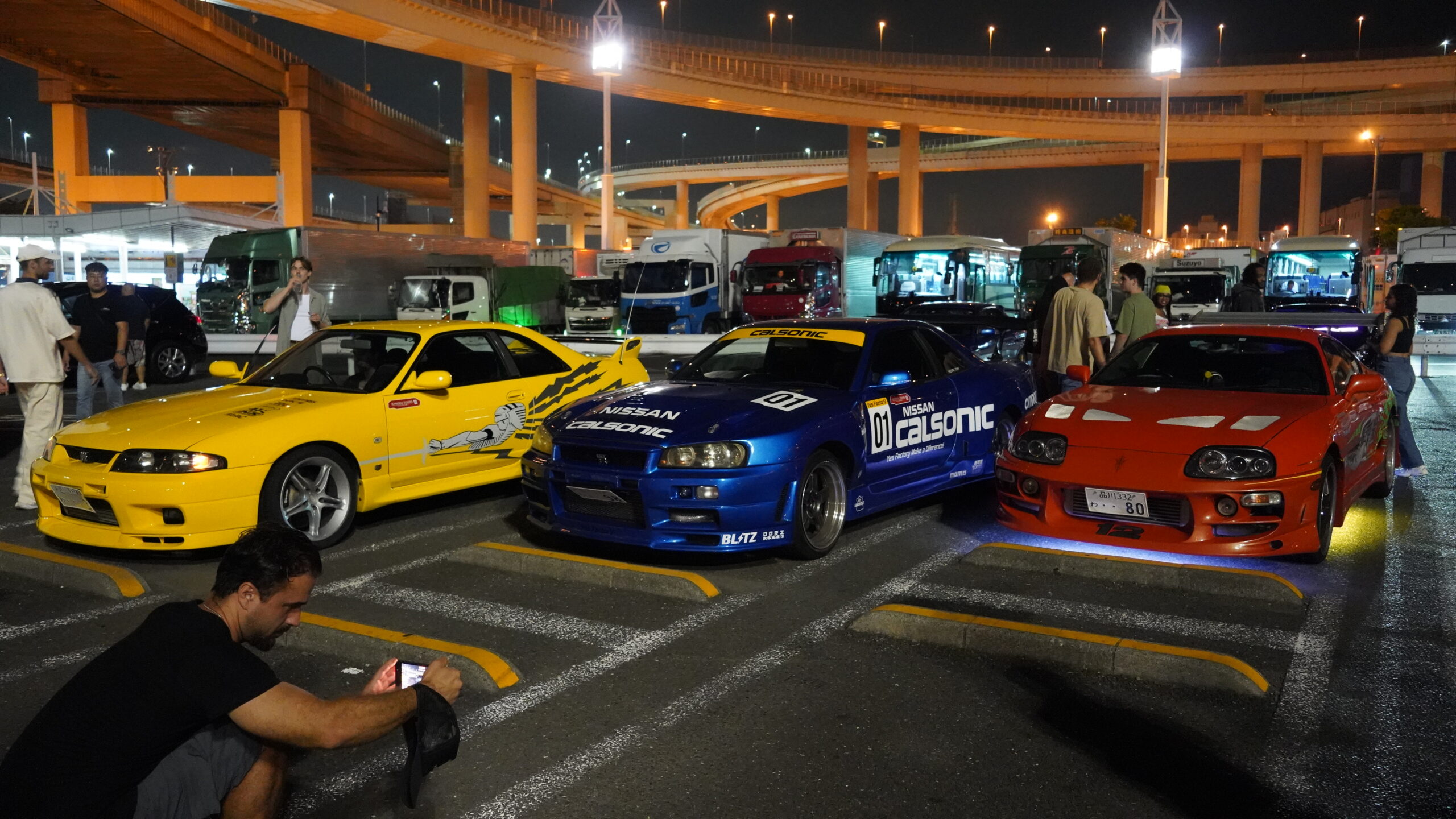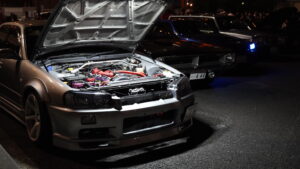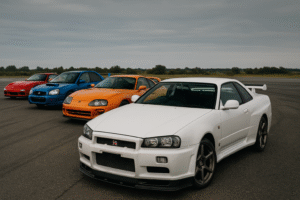Introduction: Why Daikoku PA Is Called a “Sanctuary”
Opened in 1989 alongside the completion of the Yokohama Bay Bridge, the Daikoku Parking Area (PA) has become one of Japan’s most iconic gathering spots for car enthusiasts.
What started as a scenic rest area for couples to enjoy night views has evolved into a cultural symbol — a meeting place where car lovers from around the world come together.
On weekend nights, the parking area transforms into a vibrant display of automotive passion — from JDM icons to European exotics. Yet, beneath the energy and spectacle, Daikoku PA functions on a delicate balance of mutual respect and unspoken etiquette.
For first-time visitors, understanding these unspoken rules — or “Okite” in Japanese — is essential. They’re not strict regulations, but gestures of courtesy that keep this unique place safe, beautiful, and distinctly Japanese.
Chapter 1: How Daikoku PA Became a “Holy Ground”
1-1. From Date Spot to Car Culture Hub
When Daikoku PA first opened, few imagined it would become a car enthusiast’s mecca.
In the late 1980s and early 1990s, it was known mainly as a romantic night view destination along the Yokohama waterfront.
As Japan’s tuning and street-racing scene exploded during the early ’90s, Daikoku naturally became a meeting point for drivers cruising the Bayshore Route of the Shuto Expressway.
By 1997, the opening of the Tokyo Bay Aqua-Line improved access from Chiba and other regions, fueling an even larger community.
The area’s fame eventually spread overseas. The BBC’s “Top Gear” once filmed there, showcasing Daikoku’s surreal combination of neon, supercars, and disciplined chaos — an atmosphere that could exist only in Japan.
Chapter 2: The Unspoken Rules — “Okite” of Daikoku PA
Before you visit, remember: Daikoku PA isn’t just a parking lot.
It’s a cultural space where car enthusiasts coexist.
Each “Okite” is rooted in simple manners and mutual respect — the essence of Japan’s car community.
Rule #1: Never Park in the Truck Zone
The first large section you encounter after entering the PA is reserved for trucks.
These spaces are vital rest areas for long-haul drivers who are legally required to take breaks under Japan’s road safety regulations.
Parking your car in these truck bays is strictly off-limits. Doing so not only disrupts the workflow of professional drivers but also violates the unwritten code of Daikoku.
Always park in the designated small-vehicle area, even if it means walking a little farther.
Rule #2: Do Not Park in Front of the Restrooms
One of the most common but least discussed rules: never park directly in front of the restroom area.
Those spaces are meant for short-term use by travelers who need to make a quick stop — families with children, elderly drivers, or tourists just passing through.
Parking there for long periods to socialize or take photos can cause genuine inconvenience for those who actually need to use the facilities.
Daikoku PA is a shared public space, and such small acts of consideration reflect the spirit of Japanese culture — quiet respect for others.
By avoiding unnecessary obstruction and thinking of fellow visitors, you embody what it truly means to be a responsible car enthusiast in Japan.
Rule #3: Don’t Force Your Way into a Group Lineup
You’ll often see long rows of identical cars — R34 Skylines, Supras, NSXs — neatly aligned.
These are usually owner groups or car clubs gathered informally.
For newcomers, it’s best not to squeeze into their formation uninvited.
Instead, take a slow lap to observe where different groups gather.
Parking near the front of the food court area, where there’s usually more space and a better overview, is the safest choice for first-time visitors.
Rule #4: Watch Out for the Step on the Pedestrian Path
The central walkway inside Daikoku PA has a small but sharp 3–4 cm raised curb.
Low-ride cars, especially those with front lips or aero kits, often scrape their bumpers if they cross it too quickly.
Reduce speed, approach at an angle, and be cautious.
It’s a minor detail, but protecting your car’s front end — and the reputation of JDM craftsmanship — starts with attention to these little things.
Rule #5: No Circling Around or Wrong-Way Driving
Daikoku’s layout is one-way only. Driving against the flow or looping repeatedly around the parking lot is considered bad manners and can result in police attention.
If you miss your spot or want to return to a different area, you must exit the PA, loop around via the expressway, and re-enter.
It might seem inconvenient, but it’s the safest — and most respectful — way to navigate.
Rule #6: Do Not Enter Truck Lanes or Restricted Turns
The truck lane and “no right turn” zones are completely off-limits for general cars.
These areas are designed for heavy vehicles with wide turning radii, and entering them poses a real danger.
The Daikoku Highway Patrol Substation is located right next to the parking area, and officers regularly monitor for violations.
Even a short shortcut could result in fines or citations. Always stay within the marked lanes.
Rule #7: Never Leave Your Car with the Hood Open
It’s tempting to show off your engine bay, especially with modified cars — but leaving the hood open while you walk away is risky.
Many vehicles have their chassis or engine number stamped in the bay area. Exposing this information could make your car a target for theft or cloning operations.
This risk is especially high for highly sought-after JDM models like the R34 GT-R or Mk4 Supra, which fetch premium prices overseas.
If you want to display your engine, stay nearby and keep an eye on your car at all times.
Chapter 3: Closures, Crackdowns, and “Free Vehicle Inspections”
3-1. Temporary Closures
Daikoku PA’s popularity often leads to temporary closures when congestion becomes severe.
During weekends or national holidays, closures typically begin around 8:00–8:30 PM, starting with small-vehicle sections.
Police and highway officers will sometimes instruct visitors to leave, and entrance ramps may be blocked.
However, truck areas often remain open for essential drivers, and restrooms or convenience stores (like Lawson) may stay operational.
To avoid disappointment, check the latest updates on social media or the official Shuto Expressway site before visiting.
3-2. The So-Called “Free Vehicle Inspection Days”
Regular visitors know about “Free Vehicle Inspection Days” — unofficial events rumored to occur on certain dates like July 7 (7/7), August 6 (8/6), or March 4 (3/4).
These are not actual community meets but increased police inspection operations, where officers check car modifications such as ride height, exhaust noise, and lighting.
It’s essentially a polite nickname for targeted enforcement days.
If you plan to visit on one of these dates, make sure your car complies with local regulations.
Chapter 4: General Manners and Related Situations
4-1. Wrong-Way Driving Is Never Acceptable
Inside service or parking areas, reverse driving is strictly prohibited.
Even if the law’s language is vague, any resulting accident places full liability on the reversing driver.
If you miss a space, continue forward or exit — never turn back.
It’s better to spend five extra minutes re-entering than risk an accident that could end someone’s night (or your license).
4-2. Walking Entrances and Ride-Sharing Restrictions
Many modern service areas, including Daikoku, have “Platto Park” pedestrian gates that allow entry from public roads for shopping or dining.
However, using these gates for car pick-ups, drop-offs, or rendezvous points is prohibited.
The gates exist purely for foot traffic — not for bypassing toll gates or transferring between cars.
Similarly, bus stops on expressways are for licensed buses only. Stopping a private vehicle there, even briefly, violates highway safety laws.
Chapter 5: How to Enjoy Daikoku PA the Right Way
Before You Go
- Check closure updates.
Use the official Shuto Expressway site or Twitter for live information. - Avoid peak congestion hours.
Friday to Sunday nights (10 PM–1 AM) are usually packed. - Choose your parking spot wisely.
Stay considerate and give space to others.
While You’re There
- Be friendly — conversation is part of the Daikoku spirit.
- When taking photos, blur license plates unless you have permission.
- Avoid excessive revving, loud music, or unnecessary idling.
- Keep headlights on low beam to prevent glare for pedestrians and drivers.
- Clean up after yourself — leave no trash behind.
Every small gesture contributes to keeping Daikoku beautiful and respected.
Final Chapter: Manners Create Culture
Daikoku PA is more than just asphalt and vending machines —
it’s a living monument to Japan’s car culture, a place where passion meets discipline.
What defines this “sanctuary” is not the cars themselves, but the mutual respect among those who gather there.
Avoiding the truck zones, leaving the restroom area open for real travelers, lowering your headlights for pedestrians —
these are simple acts of courtesy, but they reflect a deeper truth:
“Politeness is the most powerful modification.”
The beauty of Japanese car culture lies in its quiet orderliness, where enthusiasm and respect coexist.
To all who visit Daikoku PA:
Enjoy the machines, share the passion, and help preserve this sacred place for the next generation of car lovers.





